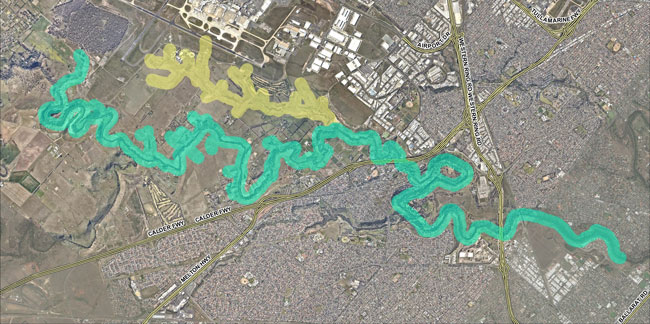
Contamination types
- Do not consume fish taken in Maribyrnong River upstream of Solomon’s Ford, Avondale Heights
- Avoid fishing, swimming or using water from Arundel Creek for stock watering. Pets should also be kept out of Arundel Creek.
Advice updated 17 April 2019
Environment Protection Authority Victoria (EPA) has extended its advice on PFAS (per- and poly-fluorinated alkyl substances) for the Maribyrnong River and is advising people not to consume fish taken upstream from Solomon’s Ford in Avondale Heights or from all of Arundel Creek.
This advice applies to the freshwater part of the river only as testing of fish in the estuarine part of the river downstream of Solomon’s Ford showed these fish had lower concentrations of PFAS.
Previous precautionary advice against using Maribyrnong River water to irrigate land has been lifted following EPA testing. Restrictions on recreational uses (such as swimming and boating) of the Maribyrnong River have also been lifted.
EPA Victoria has been working in collaboration with Melbourne Water, taking samples of water, sediment and fish to test for PFAS in the Maribyrnong River. The samples were taken from near Anglers Tavern, Maribyrnong up to Deep Creek at Bulla.
Analysis of Melbourne Water and EPA’s samples shows that there is no need for restrictions on the river for irrigation and recreational purposes such as swimming and boating.
However, due to unacceptable levels of PFAS in the fish tested, EPA recommends people not to consume fish caught in the Maribyrnong River upstream of Solomon’s Ford, Avondale Heights to Deep Creek at Bulla and within all of Arundel Creek.
This advice is in addition to existing advice from EPA to restrict consumption of fish in the lower (estuarine) Maribyrnong River due to elevated concentrations of PCBs.
Advice to avoid fishing, swimming or using water from the creek for stock watering continues to apply to Arundel Creek, a tributary of the Maribyrnong River which drains Melbourne Airport. Pets should also be kept out of the water there.
The advice does not apply to Jacksons Creek and Steele Creek.
Normal drinking water supplies are not affected.
EPA has formed a multi-agency working group including Melbourne Water, Southern Rural Water, Department of Health and Human Services, Agriculture Victoria, Victorian Fisheries Authority, and Department of Environment, Land Water and Planning and relevant councils. This working group has been reviewing the findings from the testing of water, sediment and fish to better understand any public health risks that exist in the waterways.
EPA continues to work with Melbourne Airport and Airservices Australia to manage the source of the PFAS to these waterways.